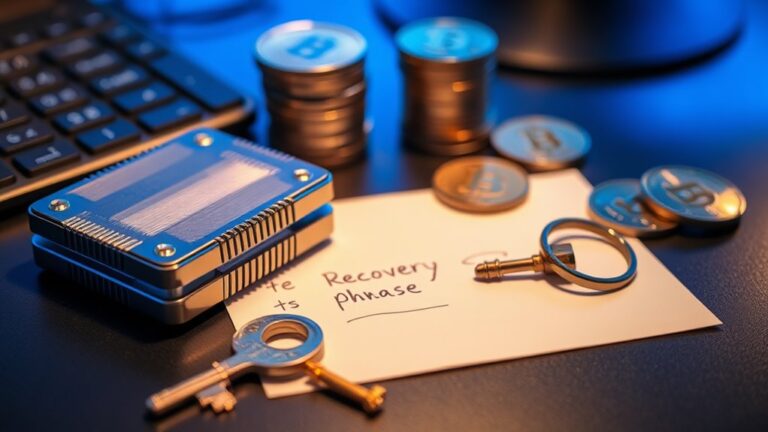What Is a Stablecoin?
Note: This post may contain affiliate links, and we may earn a commission (with No additional cost for you) if you purchase via our link. See our disclosure for more info. The gold and crypto world is constantly changing. This is not financial, investment, legal, or professional advice. So, please verify the information on the gold and cryptocurrency provider’s websites.
A stablecoin is a cryptocurrency that aims to keep its value steady, unlike the wild rollercoaster rides of typical cryptocurrencies. It does this by pegging itself to stable assets like fiat money or commodities—think of it as the calm boat in a stormy sea. With a market over $160 billion, these coins are making waves in digital finance. But hey, not all stablecoins are created equal. There's way more to unpack here.

Stablecoins, whether one likes it or not, are shaking up the financial world. These cryptocurrencies, designed to minimize price volatility, peg themselves to stable assets like fiat currencies or commodities. Imagine this: a digital dollar that doesn't lose its value faster than a melting ice cream cone. With a global market exceeding $160 billion, stablecoins are not just a trend; they're a big deal in digital finance.
So, what exactly do stablecoins do? They act as a medium of exchange, a store of value, and they make cross-border payments a snap. They're the bridge between traditional finance and the blockchain universe. Fast transactions? Check. Low costs? Double check. They're like the Swiss army knife of the crypto world, enabling decentralized finance (DeFi) applications while also providing a safe haven from the wild price swings of typical cryptocurrencies.
There are several flavors of stablecoins. Fiat-collateralized ones, like USDT and USDC, are backed by actual cash. Commodity-backed options, like PAXG, are tied to tangible assets like gold. Then, you have the crypto-collateralized ones, which are over-collateralized by other cryptocurrencies. Collateralization strategies play a crucial role in ensuring that these stablecoins maintain their value stability. Furthermore, stablecoins also offer global accessibility for financial inclusion, especially for the unbanked and underbanked in over 180 countries.
Let's not forget the algorithmic types that use smart contracts to adjust supply, though many of those have flopped harder than a bad reality TV show.
Maintaining a 1:1 parity with their pegged asset is essential for stablecoins. They promise transparency and require a tight grip on reserve management—essentially, a little honesty goes a long way. Transactions occur 24/7, offering cheaper alternatives to traditional banking systems. As we look toward 2025, experts predict that regulatory compliance will be a key factor separating the most stable cryptocurrencies from the rest.
But it's not all smooth sailing. Regulatory scrutiny is creeping in, and trust issues loom large, especially with a few notable collapses in the algorithmic sector. The risks are real.
Still, stablecoins continue to carve out their niche, challenging norms and inviting everyone to the digital finance party. Welcome or not, they're here to stay.
Frequently Asked Questions
How Do Stablecoins Differ From Traditional Cryptocurrencies?
Stablecoins and traditional cryptocurrencies? Totally different beasts.
Traditional cryptos, like Bitcoin, can swing wildly—think rollercoaster rides. One day it's up 300%, the next it's crashing down.
Stablecoins, on the other hand, cling to value stability, like a toddler to a teddy bear. They're pegged to stable assets, making them more reliable for daily transactions.
Are Stablecoins Regulated by Financial Authorities?
Yes, stablecoins are indeed regulated by financial authorities.
It's a mixed bag, though. Federal and state regulators have different rules. Some stablecoins must follow strict reserve rules, monthly audits, and even avoid using their assets for other stuff.
If they mess up? Penalties can get ugly. Think fines, bans, or worse.
And if a stablecoin issuer exceeds a certain size? They can say goodbye to state oversight. Welcome to the big leagues!
Can Stablecoins Be Used for Everyday Purchases?
Absolutely, stablecoins can be used for everyday purchases.
Platforms like BitPay and CoinGate let folks buy everything from electronics to gift cards. Retailers like AMC Theaters are on board too.
Plus, those nifty payment cards convert stablecoins into local currency at the register, making life easier.
Peer-to-peer transfers? Check. Lower fees than traditional methods? Double-check.
What Happens if a Stablecoin Loses Its Peg?
When a stablecoin loses its peg, chaos can ensue.
Think bank run, but digital. People panic and rush to redeem. Prices plummet. Confidence? Gone.
If the peg breaks, it's like watching a car crash in slow motion. Market volatility and bad design can push it over the edge.
Suddenly, that $1 promise isn't worth the paper it's printed on. Welcome to the wild world of crypto instability.
Buckle up!
Are Stablecoins Safe for Long-Term Investments?
Are stablecoins safe for long-term investments? Well, that's a loaded question.
Sure, they aim for stability, but remember, not all stablecoins are created equal. Some are backed by real assets, while others? Not so much.
Risks lurk everywhere—think depegging disasters or dodgy audits. Regulatory eyes are on them, too, which can spell chaos.












